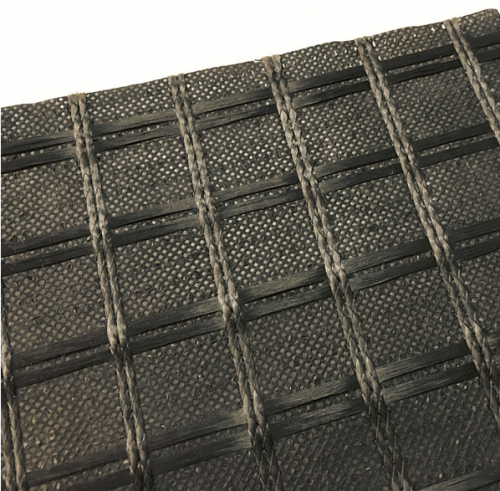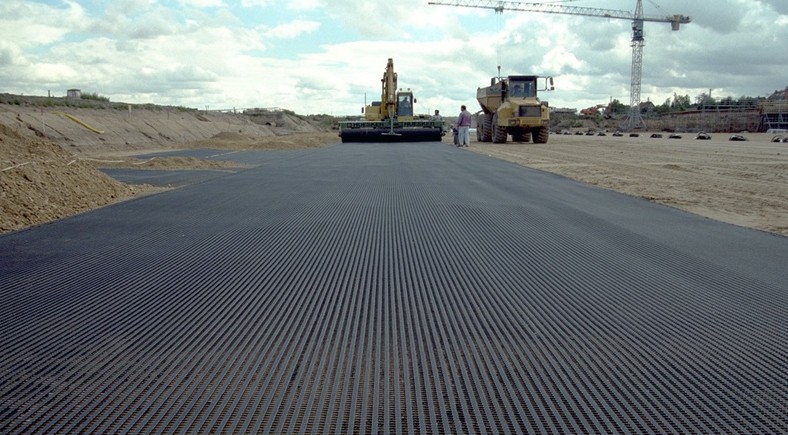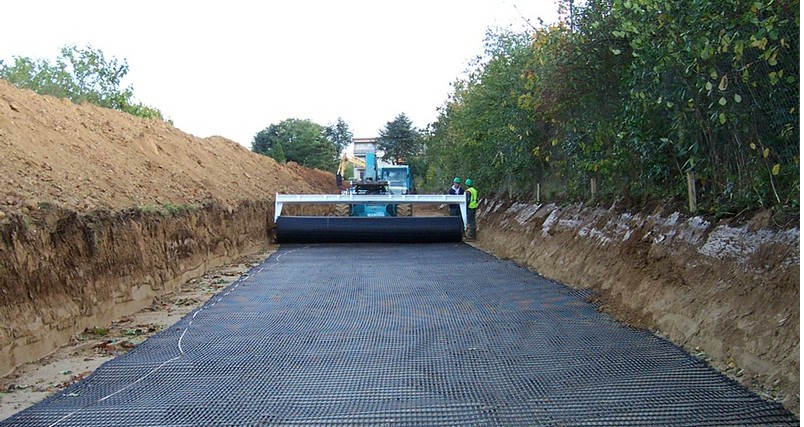Reinforcement Geogrids:
- Polyester (PET) geogrid – PET 50/50 and 100/100.
- Glass Fibre geogrid – Fibergalss 50/50 and 100/100.
*Also available in self-adhesive version
Reinforcement Composites: (Geogrid + Lightweight Geotextile)
- Polyester (PET) geogrid 50/50 and 100/100 bonded to a PET non-woven lightweight geotextile (50 – 150g/m2)
- Glass Fibre geogrid 50/50 and 100/100 bonded to a PET non-woven lightweight geotextile (50 – 150g/m2)
Installation Checklist
Proper installation techniques and construction parameters such as the use of an appropriate bonding seal, asphalt mixture ratio, particle size, proper compaction, etc. are all critical requirements to ensure a good installation outcome.
The key points include:
Storage and Handling
Surface Preparation
Bonding Coat and Application
Installation / Placement
Joints and Overlapping
Asphalt Placement
Damage and Replacement
Asphalt Reinforcement products perform best when installed in accordance with the herein described guidance, in accordance with the state or country project specifications, site conditions and suitable installation equipment/resources.
Storage and Handling
Asphalt Reinforcement products should be stored on a flat surface and in a clean dry place, protected from surface water and ground moisture. Covering the rolls may be required in wet weather or for UV protection. Rolls should be carefully moved. To avoid deformation, rolls should not be stacked over 3 high. Damaged rolls should be set aside.
Surface Preparation
The surface should be prepared according to the project specification. Perform any needed base repairs such as repair to all potholes, cracks greater than 3mm, and any badly damaged or rough pavement which may require milling (with channels no deeper than 10mm) or consider placement of a leveling course. Ensure the surface is dry, clean, and free of dust or loose stones.The surface should be smooth and even to guarantee full contact between the geosynthetic and the underlying layer without any voids.
Bonding Coat and Application
- Dependent on the underlying surface (i.e. asphalt, concrete, modified/stabilised gravel, chip seal etc.) an appropriate bituminous bond coat in accordance with the state or country project specifications should be selected to ensure a good bond strength.
- The surface must be sprayed uniformly with an asphalt cationic emulsion or pure bitumen bond coat suitable for site specific conditions, using a calibrated distributor truck. If emulsion is to be used, it is recommended to have minimum 60%-70% bitumen content. The emulsion should be allowed to completely break before installation of the geosynthetic to ensure a good bond. The softening point of the emulsion must be higher than the temperature of the subsurface. Solvent based bond coats (i.e. cutback bitumen) should not be used.
- The suggested application rate of the bond coat is 0.4 – 0.8 l/m² for smooth surfaces and 0.7 – 0.9 l/m² for milled surfaces when pure bitumen is used. The application rate should be higher (i.e.0.60 – 1.1 l/m² for smooth surfaces and 1.0 – 1.3 l/m² for milled surfaces) when 70% emulsion bond coat is used. If emulsion with less than 70% bitumen is used, the application rate may need to be increased. The application rate may vary depending on the bond coat, pavement surface, and the slope and grade of the road. The final application rate should be determined by the designer or the engineer on site. The actual amount of bond coat on the pavement surface should be measured, and in the case of asphalt geocomposites the absorption rate of the geotextile needs to be considered and not exceeded. It is very important that the bond coat application rate be verified (i.e. trialed) on site before proceeding with the complete asphalt geosynthetic installation.
- A distributor truck is preferred to obtain the most uniform bond coat application rate possible. The condition of the distributor truck should not be overlooked. Prior to beginning the job,check the spray nozzles on the truck to verify that a uniform spray is delivered. The bond coat should not be applied with heavy spots, streaks, or gaps. The height of the spray bar and spray nozzles can be adjusted to achieve the correct spray width and overlap.
Installation / Placement
- Asphalt Reinforcement may be installed on uniformly textured surfaces (the surface macrotexture must be less than 5 mm), such as milled surfaces or on old asphalt or concrete surfaces. In all cases the surface should be as smooth as possible, dry, and clean with cracks and potholes filled and compacted. A levelling layer is required over surfaces with a macrotexture greater than 5 mm and on uneven surfaces. A levelling course generally improves and simplifies the installation.
- Asphalt Reinforcement can be installed at low temperatures in accordance with installation details of the bond coat and asphalt.As soon as the bond coat starts to break, the Asphalt Reinforcement product should be installed. Do not place more than what can be paved in the same day.
- It is recommended to conduct a small trial of approximately 1m2 under the same job site conditions in advance to determine the necessary application rate, the breaking rate, and the adhesion of the bond coat.
- It is not necessary to place a bond coat over the asphalt geosynthetic, except overlapped areas.
- Folds and wrinkles of the Asphalt Reinforcement product during installation should be avoided and the product should be installed flat. For asphalt geocomposites, it should be installed with the geogrid facing up. In the case of any wrinkles, the material may be cut, sprayed with some extra binder and then over-lapped in the direction of the paving operation.
- For sharp curves, narrow width sites, irregular or non-straight edges, and other special requirements; the rolls can be cut by a sabre reciprocating saw to get a clean cut or the rolled out geosynthetic sheet cut by a box cutter knife into sections.
- For Asphalt Reinforcement products manufactured with self-adhesive characteristic, the products shall be installed to ensure that the adhesive side is facedown. Rolling with a rubbertyred roller is required to activate the adhesive face.
- After installation of Asphalt Reinforcement products, no traffic except the asphalt paver and its supplier trucks should be allowed. It is important that road work vehicles minimise hard braking and turning. Hard truck stops and sharp turns should be avoided.
- Specially equipped tractor or distributor truck designed to place asphalt geosynthetics can be used to install Asphalt Reinforcement products. This equipment has attachments to lay down and broom in the asphalt geosynthetic and apply uniform tension as the laydown operation proceeds.
- The asphalt geosynthetic can also be placed with a frontend loader using an asphalt geosynthetic placement attachment as available by us. If necessary, the asphalt geosynthetic can be installed by hand with specific considerations.
- Do not place the material when weather conditions are not suitable. Ensure the air and pavement temperature is sufficient to allow the bond coat to hold the asphalt geosynthetic in place.
- The placed asphalt geosynthetic should be wrinkle free and flat. The bond between the geosynthetic and the underlying surface should be checked by means of a spring balance test as noted in MRTS104 (≥ 9kg reading to be achieved). Furthermore, a lightweight multi-tyred or tandem roller can be used to apply sufficient pressure over the whole area to achieve a uniform and strong bond if required.
Joints and Overlapping
- The material should be checked to be clean in the overlap areas before overlapping. The longitudinal overlap of the roll shall be between 100mm and 150mm. Cross-direction or end-toend overlaps shall be between 150mm and 250mm. Cross-direction overlaps shall be shingled in the direction of the paving. Overlaps shall be properly bond coated to ensure good adhesion.
- Once the adjacent roll has been installed the overlap should be checked to ensure that full bonding has occurred, and any loose areas should be made good with additional bitumen and reworked with a stiff broom.
Asphalt Placement
- The asphalt concrete should be placed at a minimum of 130°C. Before placing the asphalt mix,ensure that the bond coat is completely broken. If an emulsion is used for the bond coat, all water should have been evaporated before placing the asphalt layer. If it rains, the geosynthetic surface should first be allowed to dry. The best practice for asphalt overlay should be followed.
- Directly after installation, the asphalt concrete must be compacted with a lightweight tandem roller. Clean the roller with an asphalt release agent if required.
- The minimum asphalt cover for Polyester (PET) and Glass Fibre geosynthetics is 40mm. For areas where high shear forces are expected, it is suggested to increase the minimum cover. Pave over the Asphalt Reinforcement on the same day of its placement.
- The joints between the paving lanes should not coincide with the overlapping of the geosynthetic material.
Damage and Replacement
- Dependent on the degree of damaged to the asphalt geosynthetics due to trafficking vehicles,these visible areas are to be repaired with another sheet of asphalt geosynthetic material keeping in mind the overlapping requirements.
- Repair any visible distress that may occur due to movement of the asphalt geosynthetic immediately after asphalt compaction. For small areas, remove the asphalt mixture from the affected area; replace the asphalt geosynthetic in its original position, and replace, level, and compact the asphalt mixture. Cut the asphalt geosynthetic as necessary to lie flat.
Troubleshooting Tips
- To reduce wrinkles, a suitable amount of tension is required on the asphalt geosynthetic when being laid, furthermore the speed of application is to be regulated and not performed too fast.Equipment used to lay asphalt geosynthetics should avoid meandering movements and stay as straight as possible.
- The bond coat application spray rate should be monitored during installation and if required, adjusted to ensure a good bond strength is being achieved. Avoid excessive application spray rates which may cause bleeding through the asphalt overlay.


